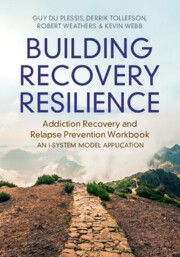 Building Recovery Resilience
Building Recovery Resilience Book contents
- Building Recovery Resilience
- Building Recovery Resilience
- Copyright page
- Contents
- Introduction
- 1 Dealing Effectively with High-Risk Situations
- 2 Coping with Cravings and Triggers
- 3 You Can’t Fix What’s Not Broken
- 4 Break the Addiction Cycle
- 5 The Requirements That Bind Us
- 6 Your Recovery Resilience Practice
- References
- Notes
- Index
4 - Break the Addiction Cycle
Published online by Cambridge University Press: 28 May 2024
- Building Recovery Resilience
- Building Recovery Resilience
- Copyright page
- Contents
- Introduction
- 1 Dealing Effectively with High-Risk Situations
- 2 Coping with Cravings and Triggers
- 3 You Can’t Fix What’s Not Broken
- 4 Break the Addiction Cycle
- 5 The Requirements That Bind Us
- 6 Your Recovery Resilience Practice
- References
- Notes
- Index
Summary
In this chapter the workbook’s previous chapters are integrated into an explanation of the dynamics that underlie the cycle of addiction. It highlights that when the I-System becomes hyperactive, individuals forfeit their innate capabilities for creative thought, open-mindedness, and resilience, exhibiting instead overly stringent expectations or assumptions about themselves, others, and circumstances. By presenting examples of thought patterns that obstruct resilience, the authors demystify the nature of problematic and unrealistic “I-System Requirements” or “the shoulds” in life that often breed frustration, physical tension, shame, or withdrawal. The reader is then guided on how to neutralize these negative thoughts or what the authors term the Depressor Storyline. They describe a self-perpetuating cycle often created between a Depressor Storyline and the Fixer Storyline, which involves the Depressor generating negative thoughts that snowball into a Storyline, while the Fixer incessantly devises stories on how to rectify self, others, or circumstances. The objective is to find means to deactivate the hyperactive I-System Requirements, which is crucial to freeing individuals from restrictive and repetitive patterns to attain a state of Natural Functioning.
- Type
- Chapter
- Information
- Building Recovery ResilienceAddiction Recovery and Relapse Prevention Workbook – An I-System Model Application, pp. 108 - 128Publisher: Cambridge University PressPrint publication year: 2024


